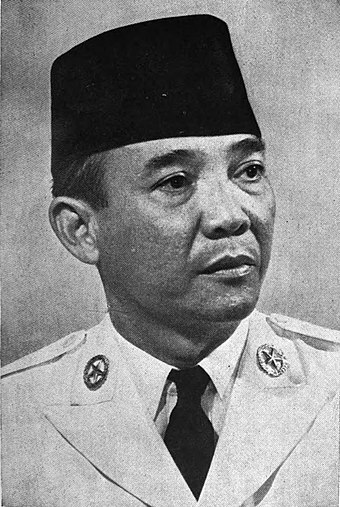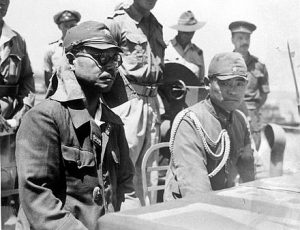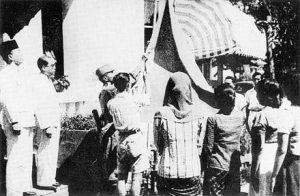Indonesian National Awakening
1908-1945 The emergence of Indonesia
In October 1908, the first nationalist movement was formed, Budi Utomo. On 10 September 1912, the first nationalist mass movement was formed: Sarekat Islam. By December 1912, Sarekat Islam had 93,000 members. The Dutch responded after the First World War with repressive measures. The nationalist leaders came from a small group of young professionals and students, some of whom had been educated in the Netherlands. In the post–World War I era, the Indonesian communists who were associated with the Third International started to usurp the nationalist movement. The repression of the nationalist movement led to many arrests, including Indonesia’s first president, Sukarno (1901–70), who was imprisoned for political activities on 29 December 1929. Also arrested was Mohammad Hatta, first Vice-President of Indonesia. Additionally, Sutan Sjahrir, who later became the first Prime Minister of Indonesia, was arrested on this date.
In 1914 the exiled Dutch socialist Henk Sneevliet founded the Indies Social Democratic Association. Initially a small forum of Dutch socialists, it would later evolve into the Communist Party of Indonesia (PKI) in 1924. In the post–World War I era, the Dutch strongly repressed all attempts at change. This repression led to a growth of the PKI. By December 1924, the PKI had a membership of 1,140. One year later in 1925, the PKI had grown to 3,000 members. From 1926 to 1927, there was a PKI-led revolt against Dutch colonialism and the harsh repression of strikes of urban workers. However, the strikes and the revolt was put down by the Dutch with some 13,000 nationalists and communists leaders were arrested. Some 4,500 were given prison sentences.
Sukarno was released from prison in December 1931 but was re-arrested on 1 August 1933.

Japanese Occupation

The Japanese invasion and subsequent occupation during World War II interrupted Dutch rule and encouraged the previously suppressed Indonesian independence movement. In May 1940, early in World War II, Nazi Germany occupied the Netherlands, but the Dutch government-in-exile initially continued to control the Dutch East Indies from its base in London. The Dutch East Indies declared a state of siege and in July 1940 redirected exports intended for Japan to the US and Britain. Negotiations with the Japanese aimed at securing supplies of aviation fuel collapsed in June 1941, and the Japanese started their conquest of Southeast Asia in December of that year. That same month, factions from Sumatra sought Japanese assistance for a revolt against the Dutch wartime government. The Japanese military defeated last Dutch forces in the East Indies in March 1942.
In July 1942, Sukarno accepted Japan’s offer to rally the public in support of the Japanese war effort. Sukarno and Mohammad Hatta were decorated by the Emperor of Japan in 1943. However, experience of the Japanese occupation of Dutch East Indies varied considerably, depending upon where one lived and one’s social position. Many who lived in areas considered important to the war effort experienced torture, sex slavery, arbitrary arrest and execution, and other war crimes. Thousands taken away from Indonesia as war labourers (romusha) suffered or died as a result of ill-treatment and starvation. People of Dutch and mixed Dutch-Indonesian descent were particular targets of the Japanese occupation.
In March 1945, the Japanese established the Investigating Committee for Preparatory Work for Independence (BPUPK) as the initial stage of the establishment of independence for the area under the control of the Japanese 16th Army. At its first meeting in May, Soepomo spoke of national integration and against personal individualism, while Muhammad Yamin suggested that the new nation should claim British Borneo, British Malaya, Portuguese Timor, and all the pre-war territories of the Dutch East Indies. The committee drafted the 1945 Constitution, which remains in force, though now much amended. On 9 August 1945 Sukarno, Hatta, and Radjiman Wediodiningrat were flown to meet Marshal Hisaichi Terauchi in Vietnam. They were told that Japan intended to announce Indonesian independence on 24 August. After the Japanese surrender, however, Sukarno unilaterally proclaimed Indonesian independence on 17 August. A later UN report stated that four million people died in Indonesia as a result of the Japanese occupation.
Indonesian National Revolution
Under pressure from radical and politicised pemuda (‘youth’) groups, Sukarno and Hatta proclaimed Indonesian independence on 17 August 1945, two days after the Japanese Emperor’s surrender in the Pacific. The following day, the Central Indonesian National Committee (KNIP) declared Sukarno President and Hatta Vice-President. Word of the proclamation spread by shortwave and fliers while the Indonesian war-time military (PETA), youths, and others rallied in support of the new republic, often moving to take over government offices from the Japanese. In December 1946 the United Nations acknowledged that Netherlands had advised the United Nations that the “Netherlands Indies” was a non-self-governing territory (colony) for which the Netherlands had a legal duty to make yearly reports and to assist towards “a full measure of self-government” as required by the ‘’Charter of the United Nations article 73‘’.
The Dutch, initially backed by the British, tried to re-establish their rule, and a bitter armed and diplomatic struggle ended in December 1949, when in the face of international pressure, the Dutch formally recognised Indonesian independence. Dutch efforts to re-establish complete control met resistance. At the end of World War II, a power vacuum arose, and the nationalists often succeeded in seizing the arms of the demoralised Japanese. A period of unrest with city guerrilla warfare called the Bersiap period ensued. Groups of Indonesian nationalists armed with improvised weapons (like bamboo spears) and firearms attacked returning Allied troops. 3,500 Europeans were killed and 20,000 were missing, meaning there were more European deaths in Indonesia after the war than during the war. After returning to Java, Dutch forces quickly re-occupied the colonial capital of Batavia (now Jakarta), so the city of Yogyakarta in central Java became the capital of the nationalist forces. Negotiations with the nationalists led to two major truce agreements, but disputes about their implementation, and much mutual provocation, led each time to renewed conflict. Within four years the Dutch had recaptured almost the whole of Indonesia, but guerrilla resistance persisted, led on Java by commander Nasution. On 27 December 1949, after four years of sporadic warfare and fierce criticism of the Dutch by the UN, the Netherlands officially recognised Indonesian sovereignty under the federal structure of the United States of Indonesia (RUSI). On 17 August 1950, exactly five years after the proclamation of independence, the last of the federal states were dissolved and Sukarno proclaimed a single unitary Republic of Indonesia.


Sukarno speaking at the Rapat Akbar (grand meeting) on 19 September 1945.
